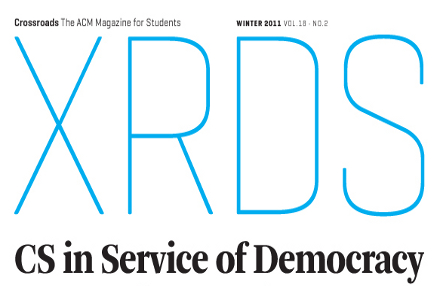Magazine: Letter from the editor
Where to go from here?
FREE CONTENT FEATURE

Where to go from here?
Full text also available in the ACM Digital Library as PDF | HTML | Digital Edition
With the relaunch of XRDS well behind us, the time has come to reflect on our progress. I could easily ramble for a few pages about where I think the XRDS team has succeeded, and also where I think we have significant progress to make. But, I'd rather open it to the readersafter all, this is a magazine by students for students.
Now that we've moved to thematic issues, the big question is: Are we selecting topics that interest you? Are they intriguing? Exciting? Are they things you've never learned about before? Or entirely pedestrian?
We've attempted to draw on a variety of fields, but without feedback, we don't know if we're hitting the mark. Does each issue interest only 10 percent of students, while 90 percent are left bored? Are there topics of universal interest? Please let us know. You might have also noticed we've been a bit more applications-focused, spending less time on theoretical or "pure" computer science topics. This is an attempt to entice a broad range of technically minded students, from high school to Ph.D. Is it working?
I should also note that we love getting pitches for issue themes. If you've got a good idea, write up an elevator pitch and a list of your "dream team" authorsyou might even get sucked in to help us put it together.
We've also got a variety of recurring columnswhat we call departmentssuch as "Labz" and "Profile." We've tried to stabilize this set over the past 18 months to provide continuity between issues. However, this doesn't mean we can't add new departments or evolve existing ones. Again, I ask, what content are we missing? If you were a XRDS editor, what column would you write four times a year?
Another topic I ponder about is the future of XRDS as a print magazine (indeed, the entire print media industry). We debated during the relaunch if XRDS should go all-digital. After much soul searching, we felt doing so would yield a lower-quality experience. We didn't want to compete with blogs like Gizmodo and Engadgetthey already do a great job. For a quarterly publication with authors, not bloggers, print seemed like the ideal medium. XRDS is something we want you to throw in your bag, read on the bus, tear articles out of, leave on the table after class, and hand off to others. Also, the complexities of digital distribution across multiple services and devices were daunting for a small volunteer team. A lot has changed in even the past two years. Is this something we should revisit? How many of you want XRDS on your Kindles and iPads? (An interactive online version is presently offered though the ACM Digital Library). Would you read it more or less if it were only offered online?
Our goal with each issue is to provide a "sampler" of articles in a particular subject area, to give students a new or deeper appreciation for an up and coming topic. This isn't unlike what our professionals-focused, sister magazine, Communications of the ACM does. So how do we craft a student-centric periodical? Currently, we do this through our departments"Advice," "Hello World," "Contests and Events" and so on. What else would you like to see?
In many ways, XRDS acts as the main conduit between students and ACM. How can we morph and enrich that relationship? Put simply, how can ACM help students? Promote technology-oriented studies? Should XRDS hold events, tours, competitions, lecture series, hack days, and similar? There are so many possible avenues; it is hard to scope the discussion. What we know for sure, is that the next generation of technologists is likely the brightest yet, and has a ton of ideas. We want to hear from you! It doesn't matter how outlandish the idea, everything is on the table. ACM's charter is promoting technology and education, and helping their members (students and professionals) to achieve their best.
Send us your comments at [email protected] or tweet with #acmxrds.
Chris Harrison is a Ph.D. student in the Human-Computer Interaction Institute at Carnegie Mellon University. Before coming to CMU, Harrison worked at IBM Research and AT&T Labs. He has since worked at Microsoft Research and Disney Imagineering. Currently, Harrison is investigating how to "interact with small devices in big ways" through novel sensing technologies and interaction techniques.
©2011 ACM 1528-4972/11/1200 $10.00
Permission to make digital or hard copies of part of this work for personal or classroom use is granted without fee provided that copies are not made or distributed for profit or commercial advantage and that copies bear this notice and the full citation on the first page or initial screen of the document. Copyrights for components of this work owned by others than ACM must be honored. Abstracting with credit is permitted. To copy otherwise, republish, post on servers, or redistribute requires prior specific permission and a fee. Permissions requests: [email protected].
The Digital Library is published by the Association for Computing Machinery. Copyright © 2011 ACM, Inc.


